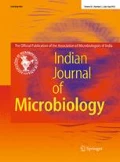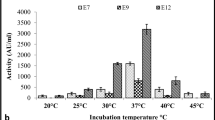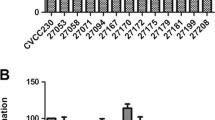Abstract
Currently, there are few reports on the isolation of microorganisms from goat milk and goat cheese that have antibacterial activity. In particular, there are no reports on the isolation of microorganisms with antibacterial activity from these products in central Mexico. Our objective was to isolate bacteria, from goat products, that synthesized antimicrobial peptides with activity against a variety of clinically significant bacteria. We isolated and identified Lactobacillus rhamnosus, L. plantarum, L. pentosus, L. helveticus and Enterococcus faecium from goat cheese, and Aquabacterium fontiphilum, Methylibium petroleiphilum, Piscinobacter aquaticus and Staphylococcus xylosus from goat milk. These bacteria isolated from goat cheese were able to inhibit Staphylococcus aureus, Bacillus cereus, Escherichia coli, Listeria monocytogenes, L. inoccua, Pseudomona aeruginosa, Shigella flexneri, Serratia marcescens, Enterobacter cloacae and Klebsiella pneumoniae. In addition, bacteria from goat milk showed inhibitory activity against B. cereus, L. lactis, E. coli, S. flexneri, E. cloacae and K. pneumonia; S. aureus, L. innocua, S. agalactiae and S. marcescens. The bacteriocins produced by these isolates were shown to be acid stable (pH 2–6) and thermotolerant (up to 100 °C), but were susceptible to proteinases. When screened by PCR for the presence of nisin, pediocin and enterocin A genes, none was found in isolates recovered from goat milk, and only the enterocin A gene was found in isolates from goat cheese.

Similar content being viewed by others
References
Escareño L, Salinas-González H, Wurzinger M, Iñiguez L, Solkner J, Meza-Herrera C (2013) Dairy goat production system. Status quo, perspectives and challenges. Trop Anim Health Prod 45:17–34. doi:10.1007/s11250-012-0246-6
Gómez-Ruiz WJ, Pinos-Rodríguez JM, Aguirre-Rivera JR, García-López JC (2012) Analysis of a goat milk cheese industry in a desert rangeland of Mexico. Pastor Res Policy Pract 2:2–11. doi:10.1186/2041-7136-2-5
Quigley L, O’Sullivan O, Stanton C, Beresford TP, Ross RP, Fitzgerald GF, Cotter PD (2013) The complex microbiota of raw milk. FEMS Microbiol Rev 37:664–698. doi:10.1111/1574-6976
Nikolic M, Terzic-Vidojevic A, Jovcic B, Begovic J, Golic N, Topisirovic L (2008) Characterization of lactic acid bacteria isolated from Bukuljac, a homemade goat’s milk cheese. Int J Food Microbiol 122:162–170. doi:10.1016/j.ijfoodmicro.2007.11.075
Perin LM, Nero LA (2014) Antagonistic lactic acid bacteria isolated from goat milk and identification of a novel nisin variant Lactococcus lactis. BMC Microbiol 14:36. doi:10.1186/1471-2180-14-36
Ekici K, Bozkurt H, Isleyici O (2004) Isolation of some pathogens from raw milk of different milch animals. Pak J Nutr 3:161–162. doi:10.3923/pjn.2004.161.162
Drider D, Fimland G, Hechard Y, McMullen LM, Prevost H (2006) The continuing story of class IIa bacteriocins. Microbiol Mol Biol Rev 70:564–582. doi:10.1128/MMBR.00016-05
Rodríguez E, González B, Gaya P, Nuñez M, Medina M (2000) Diversity of bacteriocins produced by lactic acid bacteria isolated from raw milk. Int Dairy J 10:7–15. doi:10.1016/S0958-6946(00)00017-0
Barrón-Bravo OG, Gutierrez-Chavez AJ, Angel Sahagún CA, Montaldo HH, Shepard L, Valencia-Posadas M (2013) Losses in milk yield, fat and protein contents according to different levels of somatic cell count in dairy goats. Small Rumin Res 113:421–431. doi:10.1016/j.smallrumres.2013.04.003
León-Galván MF, Barboza-Corona JE, Lechuga-Arana A, Valencia-Posadas M, Aguayo DD, Cedillo-Pelaez C, Martínez-Ortega EA, Gutierrez-Chavez AJ (2015) Molecular detection and sensitivity to antibiotics and bacteriocins of pathogens isolated from bovine mastitis in family dairy herds of Central Mexico. Biomed Res Int 2015:615153. doi:10.1155/2015/615153
Callon C, Duthoit F, Delbes C, Ferrand M, Le Frileux Y, de Cremoux R, Montel MC (2007) Stability of microbiol communities in goat milk during a lactation year: molecular approaches. Syst Appl Microbiol 30:547–560. doi:10.1016/j.syapm.2007.05.004
Barboza-Corona JE, Vázquez-Acosta H, Bideshi-Dennis K, Salcedo-Hernández R (2007) Bacteriocin-like inhibitor substances produced by Mexican strains of Bacillus thuringiensis. Arch Microbiol 187:117–126. doi:10.1007/s00203-006-0178-5
Pospiech A, Neumann B (1995) A versatil quick-prep of genomic DNA from Gram-positive bacteria. Trends Genet 11:217–218. doi:10.1016/S0168-9525(00)89052-6
León-Galván MF, Carbajal N, Frickey T, Santos L (2009) Microbial identification of the Nichupte-Bojorquez coastal lagoon in Cancun, Mexico. Aquat Ecol 43:197–205. doi:10.1007/s10452-008-9171-1
Suwanjinda D, Eames C, Panbangred W (2007) Screening of lactic acid bacteria for bacteriocins by microbiological and PCR methods. Biochem Mol Biol Educ 35:364–369. doi:10.1002/bmb.84
Rogers AM, Montville TJ (1991) Improved agar diffusion assay for nisin quantification. Food Biotechnol 5:161–168. doi:10.1080/08905439109549799
Annamalai N, Manivasagan P, Balasubramanian T, Vijayalakshmi S (2009) Enterocin from Enterococcus faecium isolated from mangrove environment. Afr J Biotechnol 8:6311–6316. doi:10.5897/AJB2009.000-9478
Alonso-Calleja C, Carballo J, Capita R, Bernardo A, García-López ML (2002) Changes in the microflora of Valdeteja raw goat’s milk cheese throughout manufacturing and ripening. LWT Food Sci Technol 35:222–232. doi:10.1006/fstl.2001.0842
Martínez JM, Kok J, Sanders JW, Hernández PE (2000) Heterologous coproduction of enterocin A and pediocin PA-1 by Lactococcus lactis: detection by specific peptide-directed antibodies. Appl Environ Microbiol 66:3543–3549. doi:10.1128/AEM.66.8.3543-3549.2000
Rehaiem A, Pérez Guerra N, Ben Belgacema Z, Fajardo Bernárdez P, Pastrana Castro L, Manaia M (2011) Enhancement of enterocin A production by Enterococcus faecium MMRA and determination of its stability to temperature and pH. Biochem Eng J 56:94–106. doi:10.1016/j.bej.2011.05.012
Lin MC, Jiang SR, Chou JH, Arun AB, Young CC, Chen WM (2009) Aquabacterium fontiphilum sp. nov. isolated from spring water. Int J Syst Evol Microbiol 59:681–685. doi:10.1099/ijs.0.000745-0
Stackebrandt E, Verbarg S, Fruhling A, Busse HJ, Tindall BJ (2009) Dissection of the genus Methylibium: reclassification of Methylibium fulvum as Rhizobacter fulvus comb. nov., Methylibium aquaticum as Piscinibacter aquaticus gen. nov., comb. nov. and Methylibium subsaxonicum as Rivibacter subsaxonicus gen. nov., comb. nov. and emended descriptions of the genera Rhizobacter and Methylibium. Int J Syst Evol Microbiol 59:2552–2560. doi:10.1099/ijs.0.008383-0
Schmidt R, Battaglia V, Scow K, Kane S, Hristova KR (2008) Involvement of a novel enzyme, MdpA, in methyl tert-butyl ether degradation in Methylibium petroleiphilum PM1. Appl Environ Microbiol 74:6631–6638. doi:10.1128/AEM.01192-08
Koop G, De Vliegher S, De Visscher A, Supré K, Haesebrouck F, Nielen M, van Werven T (2012) Differences between coagulase-negative Staphylococcus species in persistence and in effect on somatic cell count and milk yield in dairy goats. J Dairy Sci 95:5075–5084. doi:10.3168/jds.2012-5615
Broberg A, Jacobsson K, Ström K, Schnürer J (2007) Metabolite profiles of lactic acid bacteria in grass silage. Appl Environ Microbiol 73:5547–5552. doi:10.1128/AEM.02939-06
Acknowledgments
This research was partially supported by Grant from “Universidad de Guanajuato” (project 262/2013) to J. E. Barboza-Corona, and “Fundación Guanajuato Produce AC” (project FGP 583/12) to M. Valencia-Posadas, respectively. O.F. Hernández-Saldaña is a graduate student supported by CONACyT-México. We appreciate the technical support of Daniela Lisseth Contreras-González and Dr. Luz E. Casados-Vázquez from “Universidad de Guanajuato” during the process of this work.
Author information
Authors and Affiliations
Corresponding author
Electronic supplementary material
Below is the link to the electronic supplementary material.
Rights and permissions
About this article
Cite this article
Hernández-Saldaña, O.F., Valencia-Posadas, M., de la Fuente-Salcido, N.M. et al. Bacteriocinogenic Bacteria Isolated from Raw Goat Milk and Goat Cheese Produced in the Center of México. Indian J Microbiol 56, 301–308 (2016). https://doi.org/10.1007/s12088-016-0587-3
Received:
Accepted:
Published:
Issue Date:
DOI: https://doi.org/10.1007/s12088-016-0587-3




